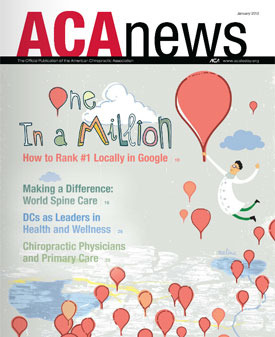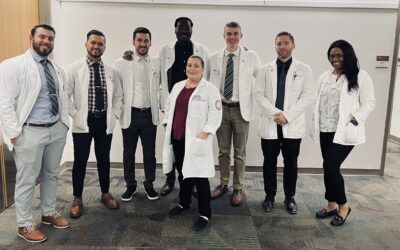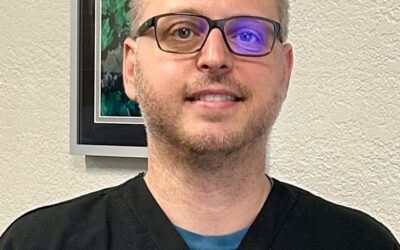Conservative Primary Care in Chiropractic Practice: Three-Part Series
Friday, March 2, 2012
This recent three-part series appeared in the January, February and March issues of ACA News. The in-depth articles were co-authored by President James F. Winterstein, faculty member David R. Seaman, DC, Robert C. Jones, DC, and alumni David C. Radford, DC (’77).
For your convenience, the complete contents of all three articles are posted here.
Part One: Chiropractic Physicians and Primary Care
By David C. Radford, DC, David R. Seaman, DC, James F. Winterstein, DC, and Robert C. Jones, DC. Reprinted with permission from the American Chiropractic Association, www.acatoday.org.
 On Oct. 23, 1967, at the 95th Annual Meeting of the American Public Health Association (APHA), Douglas Cater, special assistant to the president of the United States, presented a paper titled “Comprehensive Health Planning.”1 This was part of the early effort to determine how best to manage health care delivery in the United States. This paper and others were delivered at that APHA meeting to address the Comprehensive Health Planning and Public Health Services Amendments of 1966.
On Oct. 23, 1967, at the 95th Annual Meeting of the American Public Health Association (APHA), Douglas Cater, special assistant to the president of the United States, presented a paper titled “Comprehensive Health Planning.”1 This was part of the early effort to determine how best to manage health care delivery in the United States. This paper and others were delivered at that APHA meeting to address the Comprehensive Health Planning and Public Health Services Amendments of 1966.
In his paper, Cater made the following statement: “A recent issue of Daedalus (the journal of the American Academy of Arts and Sciences) devoted to the year 2000 reported, ‘The only prediction about the future that one can make with certainty is that public authorities will face more problems than they have at any previous time in history.'”
In 1967, not even Douglas Cater could have imagined how prescient this statement would be. Today, we have lived through that “future date” by more than a decade, and health care delivery is certainly more problematic than at “any previous time in history.” In 1967, active practicing chiropractic physicians were, in some parts of the country, appointed to Comprehensive Health Planning Councils and their principal concern was that chiropractic physicians must, at all costs, be categorized as “primary care providers,” because under comprehensive health care planning, all patients were to access health care through the primary care physician who would refer, when necessary, to a “secondary provider” (also known as a specialist), and when more urgent care was necessary, the patient would be referred to a “tertiary provider,” a specialist who worked in the hospital setting.
At that time, since no allopathic physicians were referring to chiropractic physicians, the profession was very concerned that patient flow would dry up. Accordingly, ACA and the various state organizations all promoted legislation that affirmed the primary care status of the chiropractic physician.
The Council on Chiropractic Education supported the efforts to assure the public and the governments (state and federal) that chiropractic students were fully educated as primary care physicians when “primary care” language became part of the standards in 1976 and in all standards documents since that time.2 The specific language found in the 1976 document states, “A doctor of chiropractic is a physician concerned with the health needs of the public as a member of the healing arts….The purpose of his professional education is to prepare the doctor of chiropractic as a Primary Health Care Provider.”
It should be clear that the chiropractic profession, in response to the initial efforts to craft legislative language to decide pathways for health care delivery, was determined to make the case that chiropractic provides primary care and as such its physicians must be classified as primary care providers. We are now 44 years past those early efforts and once again find ourselves working to make the case that chiropractic physicians are, and must be, primary care providers first, despite the choice of some to specialize.
A bright spot for the chiropractic profession was clearly delineated by the Alternative Medicine Integrated group as published in 20043 and again in a followup study in 2007.4 These publications clearly demonstrated that when chiropractic physicians functioned as primary care gatekeepers, pharmaceutical costs fell by 58. 1 percent and hospital admissions by 43 percent. These are statistics that clearly support the value of the chiropractic physician in the primary care, gatekeeper position.
Definitions
Recently, the health care reform act has caused the health care industry to evaluate the needs and delivery of health care for the future. As this reform takes place, definitions are being thrown about and debated by health care professionals, insurance providers, legislators and special interest groups. The definitions of key words like provider, primary care, portal of entry, primary care physician and even physician are being discussed. As a profession with a certain level of training and skills, we need to reflect honestly with ourselves as to the use of these words-how we use them and how the rest of the health care industry uses them. Recognizing how these terms are being defined within the evolving health care system will help us see where we fit into the health care system and where we, as a profession, might want to direct our primary care interests.
Only a small number of medical school graduates are seeking residencies in primary care5 and it is estimated that by 2015 there will be a 65,000-physician shortage, with that figure doubling by 2030. Can our profession, as it stands today, step in and fill this work force gap? To answer this question, we have to be realistic about the expectations of traditional primary care in the health care market. Delivering traditional primary health care today means providing comprehensive care including, but not limited to, the diagnosis, treatment, prevention and management of acute/chronic and/or complicated disease processes and integrating care with other providers or coordinated health care services as well as being the patient’s advocate.6
There are challenges to our profession to fulfill all of these expectations, and being open and honest about these challenges and our limits will take us a long way toward overcoming them. Among the challenges is the diversity of our colleagues- those wanting to participate in primary care who order technical diagnostic procedures and clinical laboratory tests versus those who want to remain subluxation based. There are those who want to treat the whole person versus those who want to treat only musculoskeletal conditions. There are those of us who want to use treatment modalities beyond the adjustment, as well as those who feel we should adjust only the spine.
Because of these intraprofessional differences, some will have a greater challenge addressing complicated disease conditions seen in traditional primary care clinics. In primary care, the physician is expected to treat end-organ dysfunction to a certain level before referring to a specialist and then to manage a chronic condition referred back from the specialist (once a treatment plan is agreed upon), and important to this model is the expectation of the physician to manage medications. Can our profession fulfill these expectations with what the health care industry and medical community consider to be truly primary care?
Treatment Models
Recently, the term conservative primary care physician has been used to describe our place in the evolving health care reform. Treatment models that are patient centric are moving to the forefront. These are models that have a primary care physician as a team member of integrated practitioners instead of the traditional individual primary care physician. Medical home, also known as the patient-centered medical home, has been evolving for decades, making comprehensive primary care a team approach that is “accessible, accountable, comprehensive, integrated, patient-centered, safe, scientifically valid and satisfying to both patients and their physicians.”7
“Conservative primary care physician” is language intended to clarify that as chiropractic physicians we do not address the complex primary care disease states that require pharmaceutical intervention and management. This part of primary care should be delivered by those practitioners who have completed the clinical training that is traditional to medical residencies, internships and fellowships. Our training strengths lend themselves to musculoskeletal conditions, as well as preventive medicine and wellness care. There are specialists in our profession who have extensive education in functional medicine and can contribute a more conservative approach to end-organ dysfunction, but this is not the general population of chiropractic physicians.
In an integrated approach to primary care, physicians can treat to their strengths and refer to colleagues in the areas of their weaknesses. As conservative primary care physicians, we can help by being a part of the team that takes the burden off the traditional primary care physicians in areas of spinal pain, sports injuries, common sprains/strains and headaches related to structural faults, and we can encourage lifestyle changes for tobacco use and alcohol and drug abuse. We can help co-manage chronic diseases like metabolic syndrome, type II diabetes mellitus, hypertension, hyperlipidemia, obesity, arthritis, osteomalacia, osteopenia, osteoporosis and malnourishment through lifestyle changes, diet, nutritional counseling and exercise. We can help manage psychosocial issues like stress, anxiety and depression, and use preventive management strategies to reduce the incidence of many common cancers, dementia and even Alzheimer’s disease.
There is a place for us in conservative primary care as a member of a larger team, and our experiences with educators in the medical community over the past five years have been favorable. As a profession, we need to strive to integrate ourselves into the nation’s health care system, rather than practice in isolation. We need to participate in the emerging multi-physician primary care approach that is being discussed in the accountable care organizations and medical home models. We must continue our educational growth, and as a profession, we need to encourage our colleges and institutions to create avenues where students and doctors of chiropractic can have greater exposure to primary care patients in an integrated setting. .
Future articles will discuss more of the operational details of how we believe Dcs can function in a primary care role.
Dr. Winterstein is the president of National University of Health Sciences, Dr. Jones is the president of New Mexico Chiropractic Association and ACA’s delegate to New Mexico, Dr. Radford is the director of the Chiropractic Clinic of Solon, Dr. Seaman is a professor of clinical sciences at National University of Health Sciences’ Florida campus, and Dr. Richardson is assistant dean, College of Allied Health Sciences and professor and director of nutrition, College of Professional Studies, National University of Health Sciences. Drs. James Lehman, and Michael Taylor also contributed to this article.
References
- Cater C, Comprehensive Health Planning, American Journal of Public Health 1968; 58,6;1022-1025.
- CCE Standards – 1976 – from the Forward to the Standards. J.Winterstein Archives.
- Sarnat R, Winterstein J, Clinical and Cost Outcomes of an Integrated Medicine IPA, Journal of Manipulative and Physiological Therapeutics 2004;27,5;336-347.
- Sarnat R, Winterstein J, Cambron J, Clinical Utilization and Cost Outcomes From an Integrative Medicine Independent Physician Association: An Additional 3-Year Update, Journal of Manipulative and Physiological Therapeutics 2007; 30,4;263-269.
- Pauline W. Chen, MD; December 11, 2008; New York Times.
- American Academy of Family Physicians; www.aafp.org/; Five definitions related to primary care.
- Martin JC, Avant RF, Bowman et al. (2004); The Future of Family Medicine: a collaborative project of the family medicine community; Annals of Family Medicine.




0 Comments